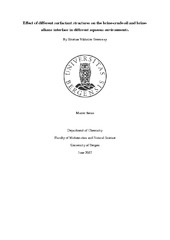| dc.description.abstract | In producing oil fields, both the production rate and ultimate recovery from the field can be enhanced by injection of chemicals into the reservoir formation. To optimise the commercial benefits, it is important to understand the interactions between the injected chemicals and the reservoir fluids. This understanding is crucial for selecting the most appropriate chemical additive for a given reservoir. This thesis investigates the interactions between oil and a brine which contains surfactant. Surfactants are chemical additives which improve oil flow from and through the reservoir by reducing the interfacial tension between the brine and the oil. The effects of three surfactants, all with different structures, were studied in relation to two crude oils and two alkanes. The three surfactants studied are Sodium Dodecyl Sulphate, Sodium Dodecylbenzene sulphonate and Aeorosol OT. This work investigated the systems’ response across a range of variables: concentration of surfactant and brine composition in terms of ion valence, brine salinity, pH and temperature. The interfacial tension (IFT) between the fluids, was measured using both the spinning drop- and the pendant drop method, as well as by measuring the system’s geometry and absorption of UV-light. The results did prove that the most effective surfactant was the one which had the most similar solubility in both the aqueous- and the oil phase. The IFT decreased with increasing salinity for all systems, until reaching a minimum, after which the IFT conversely began to increase with salinity. In tests varying the pH of the brine, the crudes exhibited their lowest IFT`s in a more alkaline environment, since acidic species in the oil were ionized, giving them a hydrophilic character. Changes in ion valence by addition of Ca^2+ also decreased the IFT for the crudes as the divalent ions created in-situ surfactants with certain compounds in the crudes. Increases in temperature increased the IFT for all systems as surfactant solubility in the bulk phase increased. | en_US |
